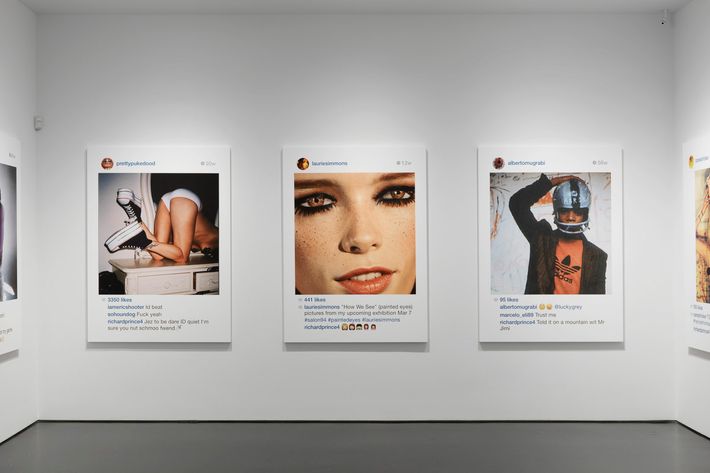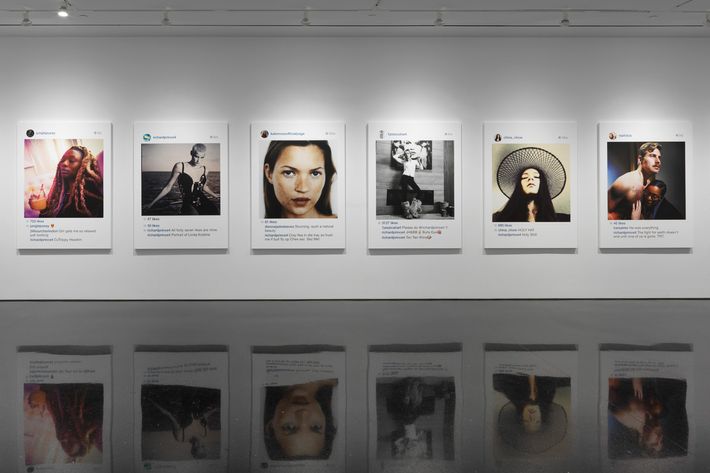
What does the internet do? The internet hates. Obviously, it does lots of other things, too — it jump-starts insurrections, appropriates, lusts, scrambles, loves cats, disrupts. But hating often seems like what the internet does best, especially when it’s got a good troll. And it’s done a lot of hating recently in response to Richard Prince’s semi-revolutionary, drop-dead simple, often salacious Instagram paintings. For these works, Prince has been called a dirty old man, creepy, twisted, a pervert. All of which may be true — but true in a great way, if that’s possible.
Thirty-seven of Prince’s New Portraits are now on view in the rear of Larry Gagosian’s store — yes, his fabulous ground floor Madison Avenue bookstore. Each is an inkjet image of someone else’s Instagram page — often a young girl posing semi-naked or maybe squatting to pee, laying on a gynecologist’s table, or taking a provocative selfie — and printed on canvasses measuring about six feet by four feet. Think of it as Prince taking his paradoxical way of appropriating and representing images to deeper digital and libidinal levels.

How easy are these pictures to make? Prince scrolls or trolls Instagram feeds. For hours. He’s a real wizard of his tastes; as honed to his needs as Humbert Humbert was to where Lolita was in the house. We could even say Prince invented our ability to notice some of the downmarket visual tropes that he’s looked for — motorcycle and muscle-car magazines, biker chicks. Now he’s turned to the ways people present themselves and their social groups to the world. Although none of the images are “his,” some of the portraits are people he knows. Fellow pictures artist Laurie Simmons is here; so is his old pal, writer and former Warhol Interview editor Glenn O’Brien, who recently wrote something that applies perfectly to Prince’s new portraits: “Andy always said the best look is a good plain look. Fashion is too vulgar.” Some of Prince’s portraits are celebrities like Pamela Anderson; most are strangers. (In truth, I spent last year wishing unsuccessfully he’d do me. Especially after I helped reinstate his Instagram page after it was taken down due to obscenity. Prince had posted his own Spiritual America, his famous appropriated Gary Gross picture of the young naked Brooke Shields.) Prince finds an image he likes, comments on it, makes a screen-grab with his iPhone, and sends the file — via email — to an assistant. From here, the file is cropped, printed as is, stretched, and presto: It’s art. Or stuff that’s driving others crazy for a variety of reasons.
But it’s what he does in the comments field that is truly brilliant, and which adds layers on top of the disconcerting images. Here he is delving as deep as he ever has into privacy, copyright, and appropriation, twisting images so that they actually seem to undergo some sort of sick psychic-artistic transubstantiation where they no longer belong to the original makers. Like I said, he’s as out there in his proclivities as Humbert Humbert. He’s recreating his “girlfriends” and gangs — grids of similar pictures so named for their visual likenesses and which, like his appropriated Marlborough cowboy pictures, put him on the artistic map. But this time, he’s not using anonymous advertising and magazine pictures; he’s going right to the source to people he can and does communicate with. They know he’s looking. And he uses his own name. Under a voluptuary in a white swimsuit, revealing her nipples, Prince comments, “Nice. Let’s hook up next week. Lunch, Smiles R.” Under a girl in short shorts posed with legs wide on a motorcycle, he writes, “I remember this so well.” He then taps an emoji of a tent and adds, “glad we had the tent.” Beneath a girl showing how long her tongue is, he writes, “Now I know.” Under a very young Jean Michel-Basquiat posted by one of the late artist’s and Prince’s biggest collectors, international megarich mogul Alberto Mugrabi, Prince writes, “Told it on the mountain wit Mr. Jimi.”
Prince is creating a rock-’n’-roll hip-hop ghetto patois of street dude, hipster, showman, Vegas lounge-lizard, flimflammer, voyeur, and hunter. This second self was always implied in his cultural gleanings. Now he’s not only closer to his subjects, he’s letting us see his relationship to them. What we have here is what literature calls “an unreliable narrator.” Is the voice we’re reading the real Prince, a made-up online self, a put on, a cover-up? This sauces everything up and plunges the work into uncomfortable waters, disallowing any easy art interpretations. The Mugrabi picture, as well as portraits of Pamela Anderson, Simmons, O’Brien, and China Chow recall Warhol’s celebrity portraits. (Warhol even pictured Chow’s father.) Looking at Prince’s Instagram feed confirms the suspicion that this series is as tightly organized and visually literate as any of his previous gangs — the large sheets with a grid of photographs of one subject. I have already made several of my own screen-grabs of his Instagram grid and plan to enlarge and print them on canvas. Either way, this work is deeper than you think.
And shallower. Look close. The New Portraits are all fuzzy and out of focus, reflecting the low quality of the digital files and iPhone lenses, not to mention what happens to this information when it’s magnified. The blurry pixels relate to the Ben-Day dots of printing and offset technologies of yore. Moreover, Prince’s slices of immaterial digital reality uploaded into physical space and placed in art galleries stretch the membrane thinner between these realms. Along with artists like Alex Israel, Frances Stark, Oliver Wasow, Ajay Kurian, Darja Bajagić, Margaret Lee, Ann Veronica, and many others, Prince is exploring the new unreal-real spaces we all live in. The cut-and-paste space of images that appear in fragments and online feeds that mingle with on line personalities, websites, and illicit behaviors. And now, real space.

Since the beginning of his career in the 1970s Prince has always been controversial. His reproducing other images in deadpan ways stretched definitions of art and has landed him on the wrong side of the law. Even the art world seemed to have sided against him in his recent run-in with copyright law in his Rasta Paintings. With these new works, the protests against him center on three things. First, he’s making money from these things, a lot of money, and given how easy they seem to be to make, that seems like theft, or at least a con; second, he’s using other people’s Instagram feeds without their permission; and most prevalently, he’s a lech for looking at and making art with pictures of young girls. Never mind that all these images shadow us everywhere now and already exist in a public uncopyrighted digital realm. And yes, he’s making money. About $40,000 a pop, to the best of my knowledge. And even though the thought of an artist raking it in at such rates when so many other artists — many of them as well known as he is — can barely get by and sell next to nothing makes me hate our current bifurcated top-versus-everyone-else system even more, the guy is a famous artist in his mid 60s. If anyone deserves it, he does. As for him “stealing other people’s pictures,” my view of an artist using other people’s Instagram pics is no different than an artist using any other material. By now, we have to agree that images — even digital ones — are materials, and artists use materials to do what they do. Period. In my way of thinking, too many artists are too wed to woefully outmoded copyright notions - laws that go against them in almost every case.
Finally, to the charge that Prince is a perv: For his entire career, this artist has culled and exposed underbellies and subcultures, making whole almost-invisible worlds visible. He has always culled marginalized personalities and lesser-known social zones. Now that the world has gone digital, these previously outsider factions are closer to the mainstream and always only a click away. By using Instagram and tapping into these self-revealing, self-documenting subgroups, Prince has eliminated the mediating middleman of the professional or fashion photographer, the advertiser, the packager. With this level of artifice eliminated, the work is more intimate — and, to some, scary. Moreover, by adding his comments, he not only leaves tracks of evidence, he reincorporates language into his work. Instead of jokes, cartoon captions, and protest signs — all of which he has painted — Prince is the author of the writing, albeit in this highly unreliable guise. If this strikes people as perverted, then Prince has always been perverted, and no argument will convince the squeamish otherwise. Regardless, Prince’s new portraits number among the new art burning through the last layers that separate the digital and physical realms. They portend a merging more momentous than we know.

